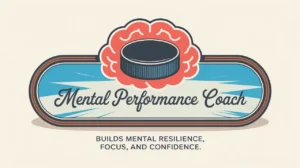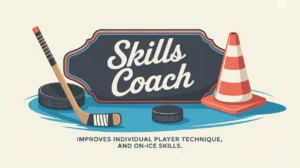Jim’s Intro to the Equipment Manager
Hi folks, Jim here, the only commentator who once borrowed a spare stick from the equipment room and somehow broke it trying to get through the door.
What is an equipment manager?
An equipment manager is the person responsible for maintaining, organizing, and preparing all the team’s gear and equipment. They ensure players have properly functioning sticks, skates, pads, uniforms, and accessories at all times. From sharpening skates to repairing gloves to managing laundry, they’re the heartbeat of team operations, quietly working before, during, and after every game.
How does it work?
Equipment managers keep everything running through maintenance, organization, and rapid problem-solving:
Gear Maintenance
- They sharpen skates, fix straps, patch pads, re-tape sticks, and repair or replace any gear that breaks.
- At higher levels, they manage specialized equipment rooms and tools.
Inventory and Distribution
- Equipment managers track, issue, and organize all team gear, including jerseys, socks, sticks, pucks, and goalie equipment.
- They keep detailed inventories to ensure nothing is missing and everything fits.
Game and Practice Prep
- They set up dressing rooms, prepare benches, lay out jerseys, and make sure every piece of gear is ready before the players arrive.
- During games, they’re constantly on alert for broken sticks, loose blades, or malfunctioning gear.
Customization and Player Support
- They tailor equipment to individual player preferences, from tape jobs to skate hollows.
- Many players rely on them for consistency and confidence in their gear setup.
Logistics and Travel
- Equipment managers pack, transport, and unload gear for road trips, ensuring everything arrives in one piece and on time.
Common Situations Involving Equipment Managers
- Skate Sharpening: Before games and practices.
- Gear Breaks Mid-Game: Quick repairs on the fly.
- Jersey Management: Assigning, labeling, and cleaning.
- Road Trips: Packing up the team’s entire gear setup.
- Player Adjustments: Tweaking sticks, pads, or helmets for comfort and performance.
How do you make good decisions with it?
Good equipment management depends on organization, consistency, and responsiveness.
- Stay Ahead of the Game: Maintenance before problems occur saves time and stress.
- Know Player Preferences: Specific details make a big difference.
- Keep Inventories Tight: Lost or misplaced gear can disrupt entire practices or games.
- Be Quick Under Pressure: Mid-game fixes need speed and accuracy.
- Balance Standardization and Customization: Not every preference can override team systems.
How do you master it?
Mastering the equipment manager role requires technical know-how, precision, and incredible attention to detail. The best equipment managers work seamlessly behind the scenes, anticipating issues before anyone else notices them. They’re part craftsman, part organizer, part firefighter.
What does it look like when done right?
A great equipment manager creates an environment where players trust their gear completely. Skates are sharp, jerseys are clean, sticks are ready, and nobody thinks twice about whether their equipment will hold up. The operation feels smooth, invisible, and reliable.
Commentator’s Corner
Jim’s Take
The equipment manager is like the pit crew and tailor rolled into one. When they do their job right, nobody notices. But if something goes wrong, everyone notices fast.
Parent Tip
Teach young players to take care of their gear early. A little responsibility goes a long way in keeping things game-ready.
Player Tip
Respect the work. Return gear properly, communicate issues early, and appreciate the quiet effort that keeps you on the ice.
A Final Thought
The equipment manager is the guardian of gear and keeper of order, blending technical skill with meticulous planning to support every shift. When mastered, the role combines craftsmanship, organization, and calm under pressure, turning chaos into smooth, reliable operations.









